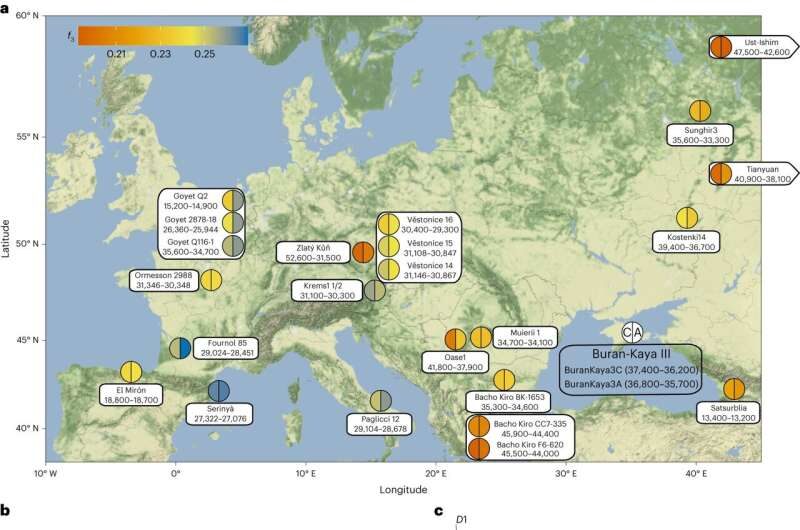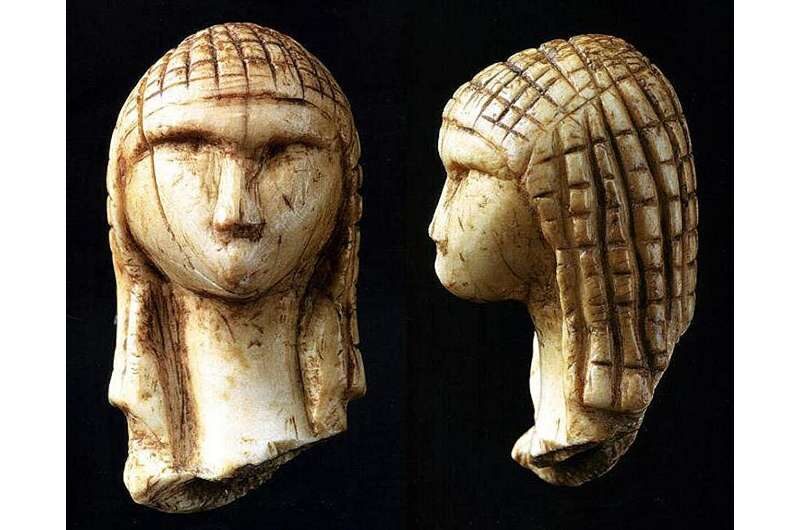
Together with lithic tools and pierced mammoth ivory beads, small skull fragments of the two skulls found in 2009 at an archaeological site in the Crimea, Buran Kaya III, bear witness to the presence of anatomically modern humans in Eastern Europe. Working with French and Ukrainian archaeologists, we were able to put in place a sampling protocol that took special precautions to prevent the fragments from being contaminated by modern human DNA and identify their ancient DNA.
The resulting analysis enabled us to generate a broad, up-to-date model of population movements, interactions and replacements as they settled in Europe during the Upper Paleolithic, the period from around 40,000 to 12,000 years ago characterized by the expansion of anatomically modern humans around the world. These individuals are the oldest representatives of Western Europeans to have established themselves permanently in Europe and to have left traces in the genomes of present-day Europeans.
It is estimated they settled in the region after the ice age that took place from 40,000 to 38,000 years ago. In addition to extremely low temperatures, the latter period was also marked by the eruption of a super-volcano in the Phlegrean Fields region near Naples, which left south-eastern and eastern Europe covered in ash.
Comment: The same fields that are seeing an uptick in activity today: 'One day it will just go off': are Naples' volcanic craters at Campi Flegrei about to blow?
Up to this day, researchers believe that the ensuing ecological crisis wiped out both the last Neanderthal populations and the first populations of sapiens humans of the early Upper Paleolithic. The latter were the descendants of the Homo sapiens populations that came from Africa around 60,000 years ago and left archaeological remains in Europe from around 45,000 years ago, possibly even earlier.
Comment: What led to the extinction of Neanderthals is still a subject of debate. And the evidence does not support the Out of Africa origin theory for all of humanity: Most human origins theories are not compatible with known fossils
Archaeologically, this was the period of transition between the Middle Paleolithic (250,000 to 30,000 years ago) and the Upper Paleolithic (about 50,000-40,000 years ago until about 10,000 years ago), as the lithic industry of the last Neanderthals was replaced by that of the first Homo sapiens. Their skeletal remains are rare, but the few that were found in archaeological sites in the Czech Republic, Romania and Bulgaria have had their genomes partially deciphered.
Present-day Europeans bear no trace of the genomes of these first sapiens Europeans, unlike the human populations that lived in Europe after the ecological crisis of 40,000 years ago, some of whose genomes have been sequenced.
Homo sapiens from interbreeding
Although the information obtained from the two skull fragments from the Buran Kaya III site is fragmentary, we were able to compare it against the 740,000 genetic variations shared with the genomes of other ancient individuals, a sufficient number to detect their affinities and shared ancestry.
Our paleogenomic analysis of these two fragments, which are thought to be 700 years apart from one another, revealed that these individuals were part of the second wave of European settlement by H. sapiens that occurred after the ecological crisis. Both individuals are descendants of distant interbreeding with Neanderthals. Our study also showed that the more recent individual bore traces of interbreeding with individuals from the first wave of settlement thought to have been exterminated by the -40,000 year ice age, represented by the Zlatý Kůň individual (-45,000 years). We were therefore able to conclude that the first H. sapiens were not completely replaced and some must have survived the ecological crisis.
The genomes of individuals from Buran Kaya III also revealed a genetic link with contemporary and much later Caucasian populations, in line with similarities identified by archaeologists between lithic tools found in the southern Caucasus and those found at Buran Kaya III at the same period. This link indicates the direction of the migration of Buran Kaya III's ancestors in Europe: from the Middle East via the Caucasus to the territory of present-day Ukraine.
Comment: They're referring to Crimea, which is actually present-day Russia.
The strongest genetic link has been identified between the genomes of individuals from Buran Kaya III and those from south-west France (see Fournol archaeological site dating back -29,000 years BC) and north-east Spain (Serinyà, -27,000 years BC) and, to a lesser extent, those from Austria (Krems-Wachtberg, -30,500 years BC) and the Czech Republic (Dolní Věstonice, -31,000 years BC) who lived 5000 to 7000 years later. These individuals, close to those from Buran Kaya III, were part of the population associated with the Classical Gravettian period, which produced the female ivory statuettes known as the "Gravettian Venuses" found in France, Germany, Austria and the Czech Republic. The famous Venus "Dame de Brassempouy" from the French department of Landes was sculpted at this time.

More information: E. Andrew Bennett et al, Genome sequences of 36,000- to 37,000-year-old modern humans at Buran-Kaya III in Crimea, Nature Ecology & Evolution (2023). DOI: 10.1038/s41559-023-02211-9
Journal information: Nature Ecology & Evolution



Comment: See also: